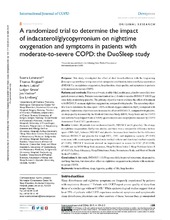| dc.Published | Lehmann S, Ringbæk, Løkke A, Grote L, Hedner J, Lindberg E. A randomized trial to determine the impact of indacaterol/glycopyrronium on nighttime oxygenation and symptoms in patients with moderate-to-severe COPD: The DuoSleep study. The International Journal of Chronic Obstructive Pulmonary Disease. 2019;14:199-210 | eng |
| dc.description.abstract | Purpose: This study investigated the effect of dual bronchodilation with the long-acting β-receptor agonist/long-acting muscarinic antagonist combination, indacaterol/glycopyrronium (IND/GLY), on nighttime oxygenation, lung function, sleep quality, and symptoms in patients with moderate-to-severe COPD. Patients and methods: This was a 4-week, double-blind, multicenter, placebo-controlled, two-period crossover study. Patients were randomized in a 1:1 ratio to receive IND/GLY 110/50 µg once daily or matching placebo. The primary objective was to evaluate the effect of treatment with IND/GLY on mean nighttime oxygenation, compared with placebo. The secondary objective was to determine the time spent <90% in blood oxygen saturation (SpO2) compared with placebo. Exploratory objectives were to assess the effect of IND/GLY, compared with placebo, on sleep quality measured by the Medical Outcomes Study (MOS) Sleep Scale and the COPD and Asthma Sleep Impact Scale (CASIS) questionnaires and on symptoms assessed by COPD Assessment Test (CAT) questionnaire. Results: In total, 38 patients were randomized (n=22, IND/GLY; n=16, placebo). The change in nighttime oxygenation (SpO2) was similar, and there was a comparable difference in time spent <90% SpO2 between IND/GLY and placebo. Increases from baseline for the difference between IND/GLY and placebo for trough FEV1, FVC, and inspiratory capacity (P<0.05) were seen, with a corresponding reduction in residual volume and functional residual capacity (P<0.05). IND/GLY treatment showed an improvement in scores for CAT (P=0.0208), CASIS, and the MOS Sleep Scale measures, Sleep Problems Index I, Sleep Problems Index II (P=0.0315), Sleep Adequacy, Sleep Disturbance Scale, Somnolence Scale, and Short of Breath Scale (P=0.0031). Conclusion: In this study, IND/GLY 110/50 µg once daily improved symptoms, sleep quality, and lung function, but showed no effect on nighttime oxygenation in patients with moderate-to-severe COPD. | en_US |

